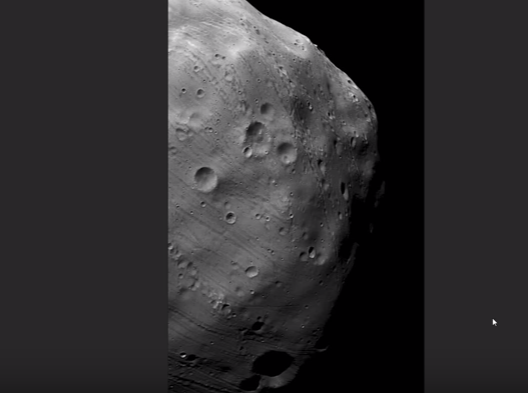By Staff Reporter, | October 17, 2016

Representation of the surface of Phobos.
Phobos, Mars' largest moon has always been a mystery. A new research conducted at LLNL has shed some light on the satellite. One of the salient features on the surface of Phobos is the 9-km mega crate also known as Stickney crater.
The Stickney crater, apart from spanning approximately half of our moon, tends to have a strong resemblance to Death Star from the movie "Star Wars." Understanding the formation of such massive craters has been quite challenging for researchers.
Like Us on Facebook
While the National Aeronautics and Space Administration is interested in new objects that could potentially threaten Earth, Lawrence Livermore National Laboratory is focused on deflecting such dangers. Popular techniques suggested include crashing a spacecraft into the heavenly object such as an asteroid to change its direction or even detonate a nuclear device near such the objects. The second aspect of the work done by Lawrence Livermore National Laboratory involves mitigating the damage if the Earth is indeed hit by a hazardous object.
The computerized 3D modeling of Phobos helps in simulating the impact on the surface that potentially resulted in a crater. The focus of the planetary defense program at LLNL is to analyze on to protect Earth from any such a devastating impact. According to the team, they were able to calculate the minimum size and speed required by an object to create the Stickney crater.
In the simulation, they were able to create the crater without destroying Phobos. Physicists at LLNL were able to show how a celestial object like a comet or asteroid could create the Stickney crater without destroying it completely. Science Daily reported that according to Megan Bruck Syal, a scientist at the LLNL, any object capable of creating the Stickney crater would have a disastrous impact on Earth and we would just one shot to resolve the issue.
Prior studies conducted, apart from not taking into consideration the porosity of the crust of Phobos and its density compared to Martian surface, could not successfully replicate Stickney craters. The new study was able to disprove that hundreds of parallel grooves could arise from the crate due to the impact. 3D simulations showed that the fracture patterns created on the surface would not be straight, long, and parallel grooves.
The research at LLNL also served as a benchmarking exercise, as they made use of open source code such as Spheral in simulating the different techniques to deflect the hazardous object.
According to Fox News, the work of the team at LLNL would be published in the journal Geophysical Research Letters.
-
Use of Coronavirus Pandemic Drones Raises Privacy Concerns: Drones Spread Fear, Local Officials Say

-
Coronavirus Hampers The Delivery Of Lockheed Martin F-35 Stealth Fighters For 2020

-
Instagram Speeds Up Plans to Add Account Memorialization Feature Due to COVID-19 Deaths

-
NASA: Perseverance Plans to Bring 'Mars Rock' to Earth in 2031

-
600 Dead And 3,000 In The Hospital as Iranians Believed Drinking High-Concentrations of Alcohol Can Cure The Coronavirus

-
600 Dead And 3,000 In The Hospital as Iranians Believed Drinking High-Concentrations of Alcohol Can Cure The Coronavirus

-
COVID-19: Doctors, Nurses Use Virtual Reality to Learn New Skills in Treating Coronavirus Patients







